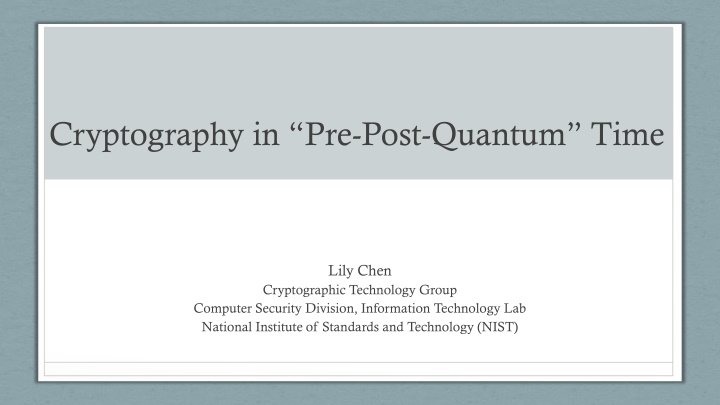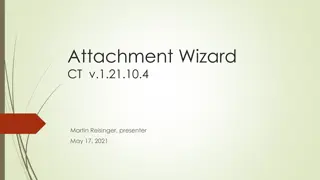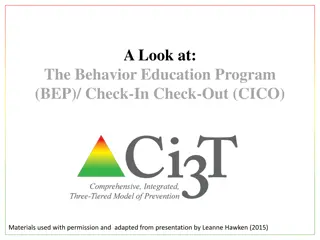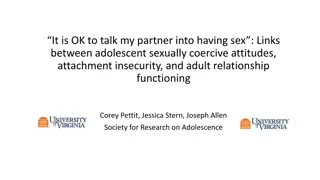
NIST Cryptographic Standards Update and Project Progress
Learn about the progress and updates on the NIST Cryptographic Standards project, including the status of submissions, first-round candidates, and standardization guidelines for post-quantum cryptographic technology. Stay informed on the latest developments in cryptography from NIST.
Download Presentation

Please find below an Image/Link to download the presentation.
The content on the website is provided AS IS for your information and personal use only. It may not be sold, licensed, or shared on other websites without obtaining consent from the author. If you encounter any issues during the download, it is possible that the publisher has removed the file from their server.
You are allowed to download the files provided on this website for personal or commercial use, subject to the condition that they are used lawfully. All files are the property of their respective owners.
The content on the website is provided AS IS for your information and personal use only. It may not be sold, licensed, or shared on other websites without obtaining consent from the author.
E N D
Presentation Transcript
Cryptography in Pre-Post-Quantum Time Lily Chen Cryptographic Technology Group Computer Security Division, Information Technology Lab National Institute of Standards and Technology (NIST)
Outline Status of NIST PQC Standardization Project and Next Steps Update on NIST Cryptographic Standards and Classical Security Preparation and migration Hash-based signatures Hybrid mode and dual signatures Symmetric key based solution Important awareness and decisions Summary
Where are we? NIST received 82 total submissions received from 25 Countries, 6 Continents The submitters in USA are from 16 States 69 complete and proper submissions accepted as the first round candidates (5 since withdrawn) The First NIST PQC Standardization Conference was held in April 2018 We are in the analysis and evaluation stage Aug. 2019 2022- 2023 Nov. 30, 2017 Dec. 2017 April, 2018
Scope of NIST PQC Standardization Guidelines Symmetric key based Public key based AES (FIPS 197 ) TDEA (800-67) Hash usage/security (800-107) Signature (FIPS 186) Transition (800-131A) Modes of operations (800 38A-38G) Key establishment (800-56A/B/C) Key generation (800-133) SHA-1/2 (FIPS 180) and SHA-3 (FIPS 202) Randomized hash (800-106) Key management (800-57) Tools HMAC (FIPS 198) RNG (800-90A/B/C) KDF (800-108, 800-135) SHA3 derived functions (parallel hashing, KMAC, etc. (800-185)
First Round Candidates Most submitted schemes (or previous versions) have been published at the conferences or released through IACR eprint In general, no big surprise Most submissions include proofs/discussions on the CCA/CPA security for Encryption/KEM and EUF-CMA for signatures Most submissions addressed the rationale for the selected parameters and mathematics structures as well as pros and cons of the schemes Signatures 5 2 7 3 KEM/Encryption 21 17 2 Overall 26 19 9 3 Lattice-based Code-based Multivariate Stateless Hash- based/symmetric key Other Total 2 5 7 19 45 64
NIST Crypto Standards Updates and Initiatives Symmetric-key based cryptography Triple DES SP 800-67 Rev2 (Nov. 2017) sets a new data limit of 220 for a given key Encryption using three-key TDEA is deprecatedthrough December 31, 2023 (see Draft SP 800-131A Rev 2) In applications where the data rate is high and enforcing a limit is infeasible, such as TLS, triple DES is no longer approved Lightweight cryptography for constrained environment (Authenticated encryption algorithms and hash functions) NIST announced draft call for proposals in May and closed on June 28, 2018 Final version will be released soon Public-key based cryptography SP 800-56A Rev. 3 (discrete log based key establishment with DH, MQV) approves IETF pre-defined safe primes (? = 2? + 1) where ? 2048 Draft SP 800-56B Rev. 2 (RSA based key establishment Include larger modulus, ? > 3072 Draft FIPS 186-5 and Draft SP 186 (digital signatures DSA, ECDSA, RSA) (release soon) Include deterministic ECDSA and EdDSA Recommended curves are defined in SP 800-186
Classical Security in Pre-Quantum Time NIST continues to improve cryptographic standards Adopt industry common practice and close gaps (e.g. predefined safe primes in 56A) Provide guidance to adopt cryptographic algorithms and key lengths with appropriate security strength (e.g. SP 800-52 for TLS) The upcoming transition to PQC should not be an excuse to stay on weak crypto or/and flawed implementations, e.g. Hard-coded keys and bad random number generators Keys with security strength less than 112 bits (e.g. RSA with 1024 bit module or DH over ??(?), with 1024 bit ?) Keys or parameters generated improperly
Stateful Hash-Based Signatures Stateful hash-based signature is out of the scope of NIST call for proposals but it is in the scope for PQC standardization Two versions of stateful hash-based signatures have been proposed in IETF XMSS RFC 8391 XMSS: eXtended Merkle Signature Scheme LMS Hash-Based Signatures (draft-mcgrew-hash-sigs-12) Input/feedback was solicited on whether NIST shall standardize any or both hash-based signatures About 20 responses were received and, in general, support NIST to standardize hash-based signatures NIST plans to initiate the project to develop a special publication on hash-based signatures Further question will be how much to limit hash-based signature, e.g. for code signing only or also allowing for root/intermediate certificates
Hybrid Mode and Dual Signatures Hybrid mode and dual signatures have been considered as a migration path from classical public key cryptography to quantum resistant public key cryptography Hybrid mode key establishment use one classical PK scheme, e.g. DH , and one quantum resistant scheme, each establish a shared secret , combine them to derive keys Dual signatures sign a message twice by two schemes, one classical signature scheme, e.g. ECDSA and one quantum resistant scheme. Dual signatures are valid if both signatures are valid Hybrid mode and dual signatures can help to obtain valuable experience for deploying quantum resistant schemes The implementation burden and performance hit need to be considered In general, it is a decision for applications Whether it is a long term or short term solution (one transition or two transitions) How to choose the quantum resistant piece to make sure it is indeed secure For hybrid mode and dual signatures, NIST FIPS 140 validation will validate approved components, that is, For hybrid mode, validation is on classical PK scheme specified in SP 800-56A or SP 800-56B For Dual signatures, validation is on the signature scheme specified in FIPS 186
Symmetric Key Cryptography Solution To deal with quantum attacks on public-key cryptography currently in use, some approaches tentatively suggest to fall back to pure symmetric key solutions through Pre-distributed key or Quantum key distribution (QKD) The pure symmetric key crypto may work if a secure key distribution/update infrastructure is in place, e.g. Cellular system with USIM card and service provider managed authentication center Kerberos to authenticate and transport keys for targeted services Quantum key distribution demands all the terminals to be equipped with quantum interface Otherwise, key distribution with protected channel is demanded Many-to-many communication networks have relied on public key cryptography to establish secure communications in the past 20 years, e.g. IKE, TLS, etc. Falling back to symmetric-key based solution proposes a challenge in key distribution
Important Awareness and Decisions Current NIST Standards cover the essential crypto primitives, in particular, for PK system Key establishments (SP 800-56A/B); and Signatures (FIPS 186) We are aware that many applications need deploying other crypto tools to provide special features such as Ring signature/group signature Identity/Attribute based encryption (IBE or ABE) Zero-knowledge proofs Foreseeing the transition to PQC, to provide the same feature in the new applications, it is very important to consider quantum resistant primitives
Summary Mind classical attacks Attackers are not waiting for quantum computers Identify and eliminate flawed implementations These are more dangerous than quantum computers For NIST PQC standardization Tell us what you can or cannot handle in your applications with regard to key size, ciphertext size, signature size, key generation, decryption failure, processing complexity, etc. and the preference in tradeoffs Prepare for the transition Facilitate crypto agility in new protocols and applications Consider quantum resistant primitives for new features
Contact Information See http://csrc.nist.gov for crypto standards, updates, call for public comments, workshops and conference Join the discussion group pqc-forum@nist.gov The 1st round candidates are posted at http://www.nist.gov/pqcrypto with presentations at the 1st NIST PQC Standardization Conference For comments, questions, or suggestions, send e-mail to pqc-comments@nist.gov






















